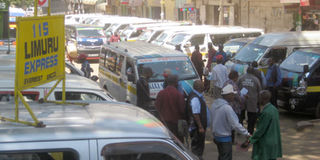Matatu madness traced to Jomo era

Matatu crew wait for passengers at the Koja terminus in Nairobi, during a crackdown as part of the enforcement of Michuki rules on November 5, 2018. PHOTO | SAMMY KIMATU | NATION MEDIA GROUP
What you need to know:
Successive governments have been trying to bring matatus under their control.
Mwai Kibaki did in 2003, with the famous “Michuki Rules”, and before him, Daniel Moi also tried 30 years ago
Public transport in Nairobi dates back to 1934 when the Nairobi Town Bus was inaugurated with only two buses serving the city.
Uhuru Kenyatta is not the first Kenyan President to try to tame madness in the matatu sector.
Mwai Kibaki did in 2003, with the famous “Michuki Rules”, and before him, Daniel Moi also tried 30 years ago when he ordered all matatus off the road and all drivers retested following accidents that had left hundreds dead and many injured.
PROTESTED
According to an archival article published in the New York Times on April 24, 1988, Moi’s efforts seem to have gone the way of his successors.
Enraged matatu operators went on a strike to protest the tough laws and, as a result, businesses were crippled, causing massive losses to traders. The government had no choice but to rescind its orders and allow unroadworthy vehicles and their rogue drivers back on the road.
FRANCHISED
Even then, the matatu industry proved too headstrong for government control.
Public transport in Nairobi dates back to 1934 when the Nairobi Town Bus was inaugurated with only two buses serving the city. Later, the Kenya Bus Services was franchised to carry the first fare-paying passengers, who were Europeans, Asians and very few Africans.
RURAL POOR
Researchers say matatus became part of the public transport in the 1950s, primarily emerging as a way to move people and goods from the rural areas to Nairobi.
“After independence in 1963, colonial restrictions about living in Nairobi were lifted. The rural poor, seeking cash wages, moved to Kenya’s capital in large numbers. The matatus, then essentially dilapidated pirate taxis that were often pursued by the police, arrived to fill this need,” writes Prof Kenda Mutongi, an history lecturer in the US, in an article titled Thugs or Entrepreneurs? Perceptions of Matatu Operators in Nairobi, 1970 to the Present and published in Africa: Journal of the International African Institute.
ACCOUNTABILITY
First President Jomo Kenyatta issued a decree recognising matatus as a legal mode of transport, while at the same time freeing them from any regulation that would have been needed to enact government legislation and accountability over their operations.
The thinking then was that matatus were a force for good and their unhindered movement was seen as a reward to enterprising owners who had taken it upon themselves to ensure that the country kept moving.
This is the perception that prevails to date, and which has seen successive governments try to fill the legal lacuna left by first President Kenyatta in a bid to bring matatus under government control.





